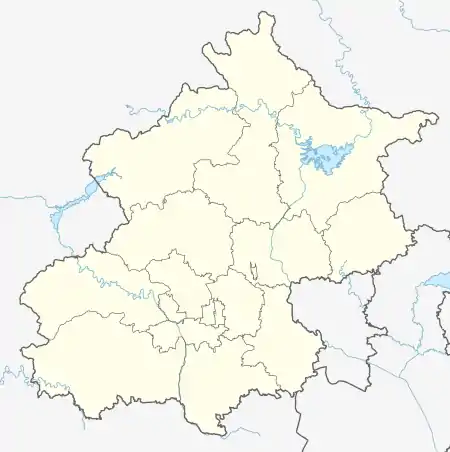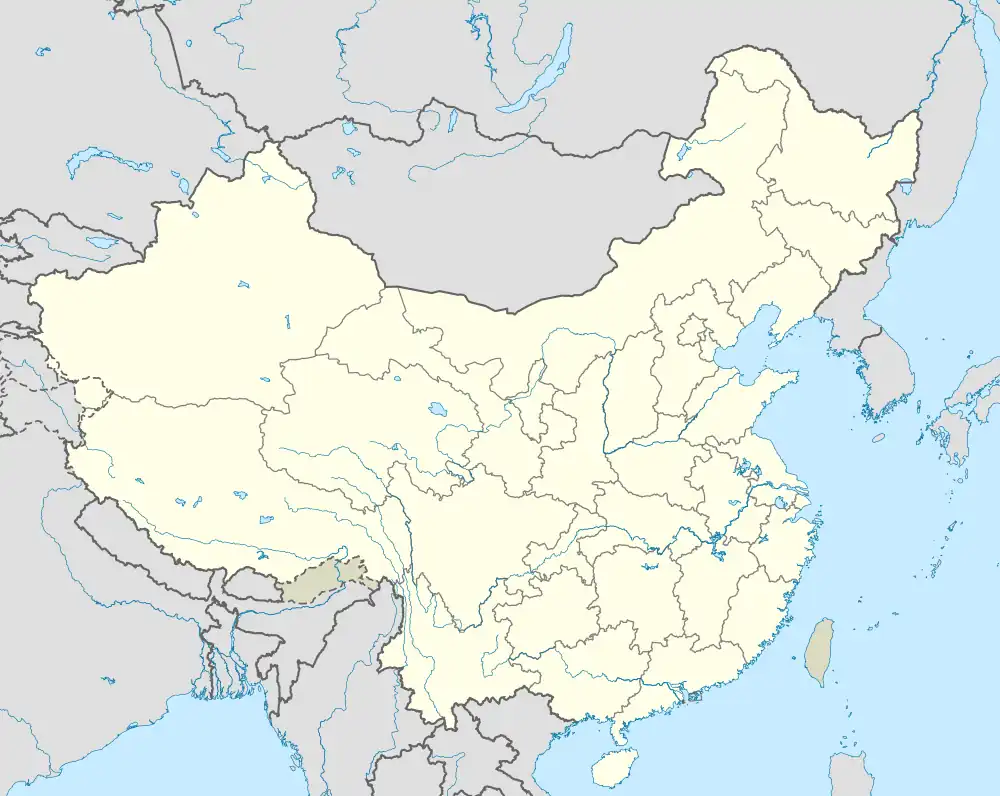Changxindian Subdistrict
长辛店街道 | |
|---|---|
.jpg.webp) An early building of CRRC Beijing 2/7 Locomotive Company within the subdistrict, 2022 | |
 Changxindian Subdistrict  Changxindian Subdistrict | |
| Coordinates: 39°49′30″N 116°12′16″E / 39.82500°N 116.20444°E | |
| Country | China |
| Municipality | Beijing |
| District | Fengtai |
| Village-level Divisions | 17 communities 2 village |
| Area | |
| • Total | 10.92 km2 (4.22 sq mi) |
| Population (2020) | |
| • Total | 85,636 |
| • Density | 7,800/km2 (20,000/sq mi) |
| Time zone | UTC+8 (China Standard) |
| Postal code | 100072 |
| Area code | 010 |
Changxindian Subdistrict (Chinese: 长辛店街道; pinyin: Chángxīndiàn Jiēdào) is a subdistrict located on the west of Fengtai District, Beijing, China. It borders Lugouqiao Subdistrict to the northeast, Changyang Town to the southeast, and is enclosed by Changxindian Town around it. The subdistrict has a 2020 census population of 85646.[1]
Changxindian (Chinese: 长辛店; lit. 'Long Pungent Shop'), the current name of the subdistrict, comes from two villages that existed in the region during Ming dynasty: Changdian and Xindian. They were merged into Changxindian during the later Qing dynasty.[2]
History
| Years | Status |
|---|---|
| 1912 | Part of Wanping County under Beijing |
| 1928 | Transferred as Changxindian Town into Hebei along with rest of Wanping County |
| 1937 | Following the Marco Polo Bridge Incident, the government of Wanping County moved into Changxindian Town |
| 1948 | Part of the 18th District of Beijing |
| 1949 | Local government was established |
| 1950 | Converted to town and transferred under Fengtai District |
| 1974 | Several Communities from Zhujiafen Subdistrict were incorporated into Changxindian |
| 1990 | Converted to a subdistrict |
| 2021 | 4 communities of Changxindian were transferred to Yungang Subdistrict |
Administrative Division
As of 2021, Changxindian Subdistrict is divided into 19 subdivisions, with 17 communities and 2 villages:[3]
| Administrative Division Code | Community Names | Name Transliteration | Type |
|---|---|---|---|
| 110106011001 | 南墙缝 | Nanqiangfeng | Community |
| 110106011002 | 合成公 | Hechenggong | Community |
| 110106011003 | 东山坡 | Dongshanpo | Community |
| 110106011004 | 北关 | Beiguan | Community |
| 110106011005 | 西峰寺 | Xifengsi | Community |
| 110106011006 | 朱家坟南区 | Zhujiafen Nanqu | Community |
| 110106011008 | 朱家坟北区 | Zhujiafen Beiqu | Community |
| 110106011010 | 赵辛店 | Zhaoxindian | Community |
| 110106011011 | 北岗洼 | Beigangwa | Community |
| 110106011012 | 崔村二里 | Cuicun Erli | Community |
| 110106011014 | 建设里 | Jiansheli | Community |
| 110106011015 | 东南街 | Dongnanjie | Community |
| 110106011016 | 陈庄 | Chenzhuang | Community |
| 110106011017 | 光明里 | Guangmingli | Community |
| 110106011019 | 玉皇庄 | Yuhuangzhuang | Community |
| 110106011028 | 长馨园 | Changxinli | Community |
| 110106011029 | 中奥嘉园 | Zhong'ao Jiayuan | Community |
| 110106011200 | 长辛店 | Changxindian | Village |
| 110106011201 | 赵辛店 | Zhaoxindian | Village |
See also
References
- ↑ "China: Bĕijīng Municipal Province". CityPopulation.de. Citing: China National Bureau of Statistics (web), Bureaus of Statistics in Beijing (web). Retrieved 30 September 2020.
- 1 2 Zhong hua ren min gong he guo zheng qu da dian. Bei jing shi juan. Li li guo, Li wan jun, Wu shi min, 李立国., 李万钧., 吴世民. Bei jing: Zhong guo she hui chu ban she. 2013. ISBN 978-7-5087-4058-4. OCLC 910451741.
{{cite book}}: CS1 maint: others (link) - ↑ "2021年统计用区划代码和城乡划分代码". www.stats.gov.cn. Retrieved 2022-09-30.
This article is issued from Wikipedia. The text is licensed under Creative Commons - Attribution - Sharealike. Additional terms may apply for the media files.